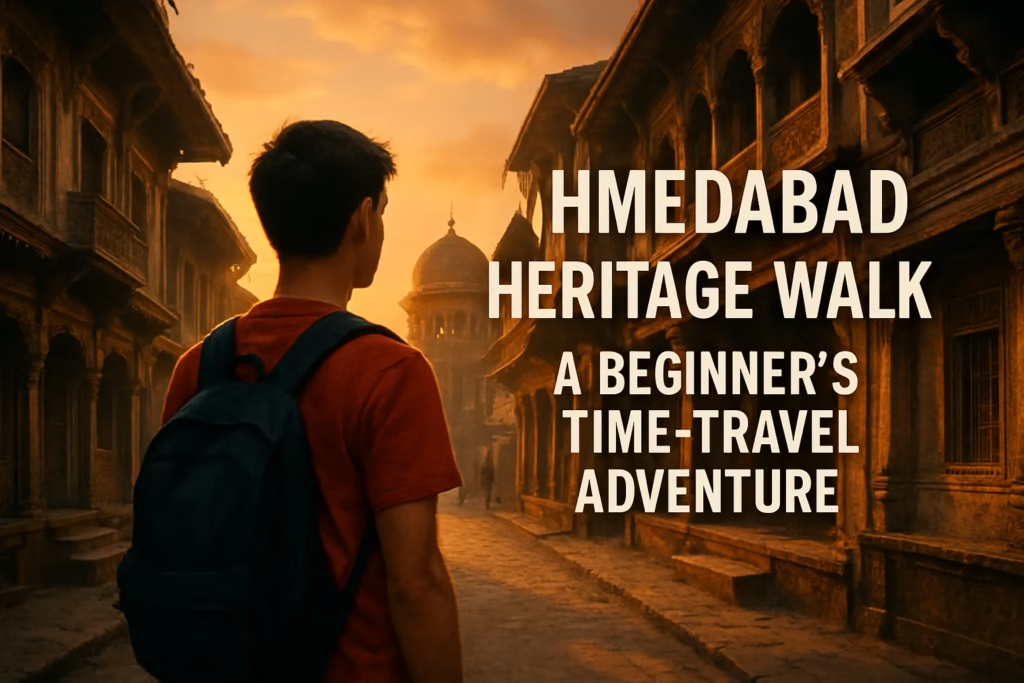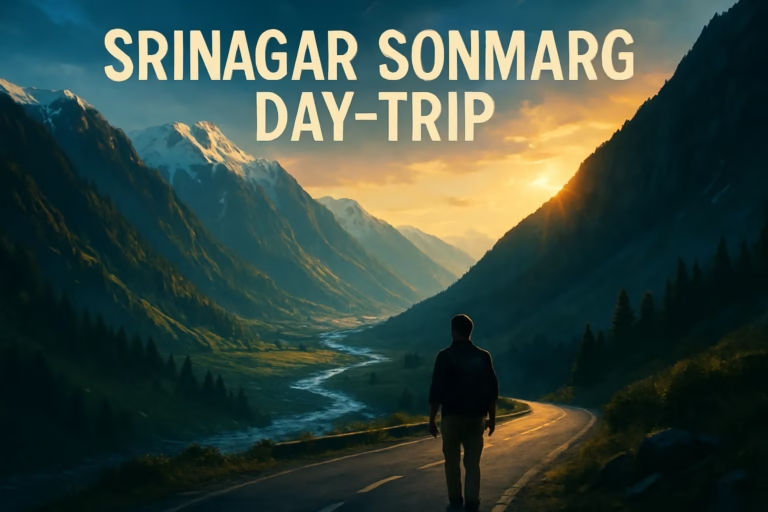A Pre-Dawn Invitation: How I Fell in Love with Ahmedabad at 7:45 AM
It was 7:32 in the morning, and most of Ahmedabad was still hitting the snooze button. Not me. I was standing outside the ornate gates of the Kalupur Swaminarayan Temple—an ivory-colored marvel that seemed impossibly serene under the first blush of dawn. The streetlights were blinking off one by one, and the only soundtrack was a distant drumbeat of temple bells and the soft scuff of my sneakers on cobblestones.
Why 7:45 AM, you ask? Because that’s when the official heritage walk kicks off. But more on that in a minute. According to the Heritage Walk Ahmedabad schedule, it starts promptly at 7:45 AM.
You lean in close, and the walls start whispering stories of emperors and masons, pilgrims and poets. You feel present in a way that Instagram can never capture. For a contrasting itinerary, check out our 7 Epic Heritage Walk in Jaipur Tours You Can’t Miss in 2025.
Why This 2.5-Hour Stroll Feels Like a Time Machine
Let’s get the facts straight:
- Start Time: 7:45 AM at Swaminarayan Temple, Kalupur, off Relief Road
- Duration: Approximately 2½ hours
- Distance: About 2 km, but packed with detours through history
- End Point: Jama Masjid (Jumma Masjid) by around 10:00–10:30 AM
For a detailed breakdown of timings, must-see spots, and practical advice, see our Ahmedabad heritage tour guide.
You could call this journey “Mandir to Masjid” if you wanted dramatic flair. And you’d be right—starting at a 19th-century Swaminarayan Temple and ending at a 15th-century mosque is no accident. It’s a living symbol of religious harmony etched into narrow lanes and sun-warmed stones.
Ahmedabad’s Walled City earned UNESCO World Heritage status in 2017, and for good reason. But what does that really mean when you’re shoulder-to-shoulder with a handful of fellow dawn-chasers? It means every carved lintel, every wooden balcony, every rickety pol (pronounced “pole,” meaning neighborhood) has a story that predates your morning coffee. And yes, you’ll probably need two.
The 8 Can’t-Miss Landmarks (and Their Secret Stories)
Before we dive in, you might want to explore our Ajanta Ellora India: When to Go, What to See & Travel Hacks and our Sightseeing at Hampi? 25 Ruins You NEED to See in 2025 for more epic architectural explorations.
1. Kalupur Swaminarayan Temple
You arrive before sunrise because the early milky light does wonders for spotting details. Those ivory pillars are more than decoration—they’re 19th-century craftsmanship testaments. Legend has it that the temple’s white marble walls were engraved by artisans who chiseled so precisely, their tools whispered through the stone like the city’s collective heartbeat. Bonus: the land was granted by a British officer so impressed by Swaminarayan’s social work that he ordered a 101-gun salute at inauguration. Can’t rival that at your local community center.
2. Bhadra Fort & Teen Darwaza
A short stroll takes you to the imposing Bhadra Fort, built by Sultan Ahmed Shah in the 1400s. Inside, you’ll glimpse the Bhadrakali Temple, where vibrant prayers and royal processions once filled the air with color and chant. Next door stands Teen Darwaza—“Three Gates”—the ceremonial entrance to the Maidan Shah. Seek out the whispered queen’s legend: some say her ghost still manifests in the breeze that rattles the ancient wooden door.
3. Jami Masjid (Ahmed Shah’s Mosque)
Step into the courtyard of this 1414 marvel and your eyes will dance from Islamic geometric arches to Hindu lotus motifs carved in the lattice screens. The famed jali window—one of 51 variations—casts patterned shadows that photographers drool over. It’s architecture that cools the prayer hall naturally, proving that function and beauty are lifelong friends here.
4. Badshah no Hajiro
This mausoleum houses the tombs of Ahmed Shah, his son, and his grandson. Here’s the twist: tradition bars women from entering. Whether you view it as a protective custom or a curious quirk, it underscores how heritage walks aren’t just about pretty buildings—they’re also about layers of belief that have evolved over centuries.
5. Shantinath ni Pol
Enter one of Ahmedabad’s famed pols—tight-knit neighborhoods with ornate wooden doors and communal otlas (platforms) for gossip and chai. The Jain temple tucked inside is a lesson in serenity: delicate pillars, silent halls, and a sense that the world outside these walls could wait until later. Hint: it always does.
6. Sidi Saiyad Jali & Stone Lacework
If there’s an emblem for Ahmedabad, this is it. The Sidi Saiyad window is stone lace carved in the 1600s by Sidi Saiyad’s craftsmen. Peer through its arches and you’ll see a fractal of octagons and stars that feels infinite. Fun fact: locals say gazing at it makes you more patient—trust me, it might just work on your social media scrolling habit, too.
7. Manek Chowk Market
By now, the sun is higher, and Manek Chowk is morphing from a bustling vegetable and spice bazaar into a sizzling street food hub. Early risers haggle over greens; late sleepers salivate over pani puri and pav bhaji stalls. It’s a square that never truly sleeps—switching hats from market to feast before lunch hits.
8. Mangaldas ni Haveli & Khetrapal Shrine
The final stretch leads you past an opulent haveli, once home to a silk-trading magnate. Its courtyard echoes with the footfalls of traders who once negotiated bolts of fabric here. Peek around the corner to find the Khetrapal Jain Shrine—an informal, caste-less corner of devotion that celebrates inclusion in stone and incense smoke.
For more traveler reflections and detailed anecdotes, see this Ahmedabad Heritage Walk blog post.
Pro Tips to Glide Through Your Heritage Walk
- Booking Essentials: Tickets are Rs. 200 for the standard package and Rs. 400 for the luxury package (includes breakfast and water). You can buy on-site at the temple or book online via the official heritage walk site.
- Dress Code Decoded: Shoulders covered, skirts or shorts at or below knee length. If you need, carry a scarf or shawl to quickly cover up. Respectful headgear is welcome at mosques.
- Shoe Game: Flip-flops are a no-go. Pick sturdy, comfy kicks—think sneakers or closed-toe walking shoes. Your feet will thank you.
- Language & Group Size: English is the most common lingua franca, though guides may sprinkle in Gujarati. Expect around 15–20 fellow walkers—that sweet spot for camaraderie without elbowing for view.
- Rain or Shine? Winter (November to February) and post-monsoon (October) are ideal—cool mornings, minimal dust, and clear skies. Avoid the peak summer months unless you fancy a sauna session.
Insider Hacks for First-Timers
Photo Magic: Aim to shoot the latticework and arches when the sun is still low. Harsh overhead light kills detail; soft morning rays are your best friend. Try shooting from waist height through windows for dramatic silhouettes.
Crowd-Dodging: Yes, some spots fill up fast. RSVP or show up early (around 7:30 AM) to claim your spot. Once you’re in the group, you’ll breeze past the ticket counter and straight into history.
Solo-Traveller Boost: Feeling shy? Share a packet of local snacks—like khakhra or mango sharbati biscuits—with your neighbor. Instant icebreaker, guaranteed smiles, and maybe a new walking buddy.
Hydration Station: Pack a reusable water pouch. The walk includes a short break, but carrying water and light nibbles (think roasted peanuts or sev) keeps energy levels up without stopping the flow.
When Culture and Cuisine Collide: Post-Walk Pit-Stops
By the time you reach Jama Masjid, your stomach might be chanting prayers of its own. Good news: the best Gujarati thali in the Walled City is just around the corner. Head to Shree Thaker Bhojanalay for a spread of undhiyu, rotla, dal dhokli, and sweet shrikhand under the mosque’s towering minarets.
Next, drift into one of the tiny tea stalls where local elders sip adrak chai and swap neighborhood tales. You might overhear someone recounting how the city looked before British railway tracks cut through the pols—a reminder that history is always alive in these lanes.
Finally, sweeten your send-off with a jalebi from the stall opposite Teen Darwaza, or test your palate at a paan-masala counter near the Bhadra Fort exit. Either way, your taste buds will memorialize the city long after your camera’s memory card is full.
Looking Back (and Forward): Your Passport to Ahmedabad’s Soul
Two and a half hours. Twenty pause points. A stroll that weaves through four centuries of art, architecture, faith, and community. If the rest of Ahmedabad moves at its own bustling pace, this heritage walk is your invitation to slow down and listen.
Which corner of the Walled City will you explore next? Will it be the sun-baked majesty of Hathee Singh Jain Temple, the silent poetry of Astodia Gate, or the hidden frescoes inside a 17th-century haveli? The old city awaits your curiosity.
Hungry for more curated, zero-stress group adventures? Download the Kozyclan app and turn your next getaway into a community celebration! Explore our 15 Epic Group Trip To Goa Deals for 2025 or plan high-altitude journeys with our 10 Unbelievable Tour Packages for Leh Ladakh in 2025.


